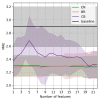Wellbeing Forecasting in Postpartum Anemia Patients
- PMID: 37372812
- PMCID: PMC10298600
- DOI: 10.3390/healthcare11121694
Wellbeing Forecasting in Postpartum Anemia Patients
Abstract
Postpartum anemia is a very common maternal health problem and remains a persistent public health issue globally. It negatively affects maternal mood and could lead to depression, increased fatigue, and decreased cognitive abilities. It can and should be treated by restoring iron stores. However, in most health systems, there is typically a six-week gap between birth and the follow-up postpartum visit. Risks of postpartum maternal complications are usually assessed shortly after birth by clinicians intuitively, taking into account psychosocial and physical factors, such as the presence of anemia and the type of iron supplementation. In this paper, we investigate the possibility of using machine-learning algorithms to more reliably forecast three parameters related to patient wellbeing, namely depression (measured by Edinburgh Postnatal Depression Scale-EPDS), overall tiredness, and physical tiredness (both measured by Multidimensional Fatigue Inventory-MFI). Data from 261 patients were used to train the forecasting models for each of the three parameters, and they outperformed the baseline models that always predicted the mean values of the training data. The mean average error of the elastic net regression model for predicting the EPDS score (with values ranging from 0 to 19) was 2.3 and outperformed the baseline, which already hints at the clinical usefulness of using such a model. We further investigated what features are the most important for this prediction, where the EDPS score and both tiredness indexes at birth turned out to be by far the most prominent prediction features. Our study indicates that the machine-learning model approach has the potential for use in clinical practice to predict the onset of depression and severe fatigue in anemic patients postpartum and potentially improve the detection and management of postpartum depression and fatigue.
Keywords: Edinburgh Postnatal Depression Scale; Multidimensional Fatigue Inventory; fatigue; machine learning; postpartum anemia; postpartum depression; wellbeing forecast.
Conflict of interest statement
The authors declare no conflict of interest. The funders had no role in the design of the study; in the collection, analyses, or interpretation of data; in the writing of the manuscript; or in the decision to publish the results.
Figures
References
-
- Simoes E., Kunz S., Bosing-Schwenkglenks M., Schmahl F.W. Maternal postpartum anaemia–tendencies and variability, considering different hospital categories–research on the basis of perinatology in Baden-Württemberg. Z. Geburtshilfe Neonatol. 2004;208:184–189. doi: 10.1055/s-2004-832638. - DOI - PubMed
Grants and funding
LinkOut - more resources
Full Text Sources
Miscellaneous


